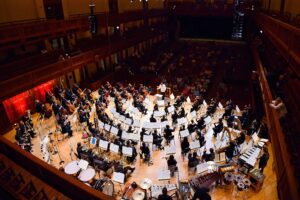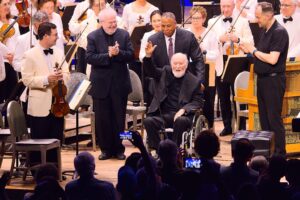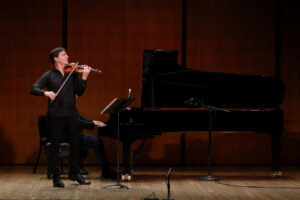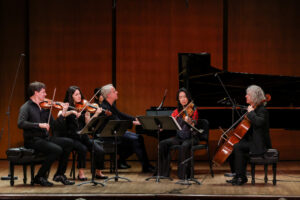
Microfest Records has released My Dancing Sweetheart, a new album that features music by composers Ben Johnston, Bill Alves and Helmut Oehring. The performers are all first-rate Los Angeles musicians and include Stacey Fraser, vocals, Aron Kallay, keyboards, Shalini Vijavan, violin and Nick Terry, percussion. Subtitled “Just Songs”, My Dancing Sweetheart is an accessible and engaging introduction to the world of Just Intonation and contemporary tonal palettes.
Just Intonation is a tuning system that is based on optimizing the frequency ratios between the notes in the scale. Our conventional 12 Tone Equal Temperament tuning, by contrast, assigns specific frequencies to each note, allowing fixed pitch instruments to play in any key and transpose music easily. This simplifies harmony and chord progressions and has been the standard tuning system for western music since the mid-19th century. By fixing the frequency of notes, however, the Equal Temperament system compromises somewhat the intervals between the notes in the scale. Just Intonation tuning addresses this but requires the re-tuning of the instruments to a specific fundamental frequency. The advantage lies in that the resulting scale tones are more closely related harmonically and bring out the purity and consonance of the intervals.
American composer Harry Partch (1901-1974) was an early champion of Just Intonation and he built a number of experimental instruments to perform his works. Other composers followed during the 20th century, including Lou Harrison, Ben Johnston, Pauline Oliveros and James Tenney. Experimentation has been a consistent feature of the Los Angeles new music scene in our 21st Century, and the performers on this album have many years of concert experience playing in alternate tuning systems.
My Dancing Sweetheart is subtitled “Just Songs” and so it is appropriate that the first two works on the album, Calamity Jane and Ma Mie Qui Danse were composed by tuning pioneer Ben Johnston. Kyle Gann, composer and student of Johnston, has stated that: “Not all musicians realize it, but Ben Johnston, was a major figure in the Midwestern new music world in the 1970s and ‘80s, comparable to John Cage on the East Coast or Lou Harrison on the West. He looms even larger in the world of microtonal music, for his string quartets, sonatas for retuned keyboard, and other works are among the most compelling works ever written in alternate tunings.”
Composed in 1989, Calamity Jane is based on a series of fictional letters by the notorious wild west character to her daughter. These are a series of short pieces – all less than three minutes – sung by soprano Stacey Fraser, accompanied by Aron Kallay, Shalini Vijavan and Nick Terry. What does alternate tuning bring to Johnston’s music? As John Schneider explains in his eloquent liner notes: “The addition of these new notes provides the composers with an extraordinary new palette of melody and harmony, supported by a retuned piano, and in Calamity Jane, an equally facile violin.”
Johnston, however, does not overwhelm the listener with the unorthodox. Like Harry Partch before him, whose music was inspired by a lighthearted look at depression-era life on the road, Johnston begins Calamity Jane with something familiar: a 39 second soprano solo in a quiet, confessional style. “No. 1 Freely, Like Speech” is a short letter to Janey, Calamity Jane’s young daughter, that lovingly describes her family resemblance: “I like this picture of you: your eyes and forehead are like your father, lower jaw, mouth and hair like me.”. Ms. Fraser’s poignantly expressive vocals here are approachable and compelling, establishing an intimate human connection that carries through the entire work.
More letters follow describing various episodes, and these can be energetic, playful or solemn. “No.2 In Motion with a beat”, is an action filled letter to Janey explaining how Calamity met her father, Wild Bill Hickok, during a shootout near Abilene, Kansas. The stirring vocals are augmented by piano, percussion and violin, establishing an undercurrent of tension and movement. The dynamic balance of the ensemble is ideal; the sound engineering by Scott Fraser is up to his usual high standards. The vocals throughout are critical and are allowed to dominate.
“No. 4 Rather Slowly, but moving forward”, is just that, with the accompaniment in alternate tuning, There is a lovely violin line along with a programmable keyboard that nicely matches the mood for this piece. Ms. Fraser’s vocals have strength in every register and make for a solid exposition of the complicated narrative. “No. 5 Lively but not too fast” has a country music flavor, and describes a dust up in the Deadwood saloon between Calamity Jane and some judgmental local women. A nice beat and a wandering violin line by Ms. Vijavan frame the exuberant vocals.
“No. 6 Waltz-like” is a bit more matter-of-fact and describes the tricks and stunts Calamity performs as part of Bill Cody’s Wild West Show. This piece features a solid beat in the accompaniment in a lively tempo along with agile singing by Fraser.
“No. 7 Slowly” is Calamity Jane slowly singing her recipe for a cake, with most of the lyrics consisting of a simple list of ingredients. The vocal pitch rises with each item listed until Ms. Fraser is singing in a very high register, but she never loses power or control on the ascent. The movement concludes with “This cake is unexcelled and will keep good to the last crumb 20 years.” The final movement is “No. 8 Freely, like Speech” and closes out the diary of letters by Calamity Jane to her daughter. This bookends the first movement with a vocal solo lamenting Calamity’s coming blindness in old age. Sweetly and expressively sung, this is introspective and especially poignant.
Calamity Jane has all the elements of an appealing story: drama, excitement and intrigue populated by likable and colorful characters. The use of alternate tuning never seems to intrude on the narrative, and compliments what is a fine ensemble piece, artfully performed. The dominance of the vocals forge a special human connection with the listener, masterfully sung by Stacey Fraser. Calamity Jane nicely threads the needle between what a listening audience will enjoy and what they might learn about contemporary alternate tuning.
The second Ben Johnston work on the album is Ma Mie Qui Danse, written in 1991. For inspiration, Johnston travels to the opposite end of the personality spectrum, away from the irrepressible Calamity Jane, reaching out instead to adorable innocence. The text of Ma Mie Qui Danse is taken from audio recordings of Johnston’s three year-old granddaughter who, as children often do, sang her own improvised poetry. Building on this, Johnston also included some appropriate selections from the works of Emily Dickenson. This piece is performed as a duo with soprano Stacey Fraser and Aron Kallay on the keyboard.
“No 1. Sprightly” is the first movement, and introduces the granddaughter. A bouncy piano accompaniment provides the launching pad for a number of short, jumpy phrases in the vocals. The singing is agile and angular, full of the starts and stops of toddler enthusiasm, as can be seen from this fragment of the text:
“cause we go a seek and we go very boy
oh, did you remember him’
he was tamer me
and he had and he greet me
for six hundred money
and dream
Mister dream
how he gave me Santa”
Other movements based on the Emily Dickenson texts are more reserved, as with movement “IV. Slow and Tranquil”, The singing here is both forthright and mature, and in a more conventional style.
“A bird is of all beings
The likes to the dawn.
An easy breeze does put afloat
The general heavens upon.”
As the movements proceed, the contrast between the broadly expressive Dickenson and the enthusiastic outbursts of youth constantly refresh the ear, enhancing the feelings expressed by each. The accompaniment and the alternate tuning compliment the emotional force of the singing. The last movement, powerfully sung with a spare accompaniment, sums up the perspective of Ma Mie Qui Danse:
“The child’s faith is new
Whole – like his principle
Wide
Like the sunrise
On fresh eyes
Never had a doubt
Laughs at scruple,
Believes all sham but Paradise!”
Ma Mie Qui Danse is a delightful musical pairing of youthful exuberance and mature reflection.
Bill Alves has contributed two works to the album, Time Resonances (2012) and A Sonatina (2016). These are both single-movement pieces of about 7 minutes each. Alves is a composer and educator, as well as the co-author of a scholarly biography of Lou Harrison. He is co-director of Microfest, the annual festival in Los Angeles dedicated to microtonal music.
As Alves explains in the liner notes, Time Resonances is “…a technological elaboration of a medieval musical genre known as a ‘mensuration canon,’ a piece in which the melody is combined with itself but at a different speed.” Stacey Fraser performs all the parts separately, and these are then combined electronically at different lengths but with no change in pitch. Time Resonances opens with gentle bell tones in various registers. Sustained vocals enter, creating lovely chords that mix well with the bell tones. There are no lyrics in this, just abstract ahhhs and ohhhs. The tempo is moderate with independent vocal lines soaring and gliding in and around each other. The feeling is gently mystical with a sense of standing outside of time. The dynamics rise and fall but only moderately, producing graceful tides of sound. Interesting harmonies develop and subside, slightly dissonant at times. The singing is disciplined and the electronic processing precise. Time Resonances masterfully combines the abstract with the human voice to evoke in the listener a glimpse of the infinite.
The second Alves piece, A Sonatina, draws its inspiration from the poetry of Gertrude Stein. Alves writes in the liner notes about Ms. Stein: “At times, she went even further, making language into a fascinating abstraction, which has long appealed to me as a composer, as has her musical perspective of language, her use of repetition, and the seeming simplicity of her supposed ‘difficult’ works.” All these elements can be found in A Sonatina, performed by Stacey Fraser, Aron Kallay and vocalist Donna Walker.
The piece begins with a string of high piano notes in a fast repeating phrase, simple at first but slowly gaining more structure and complexity. The vocals enter, first spoken by Donna Walker and then sung by Fraser as a sustained melody. The active piano accompaniment by Aron Kallay is controlled and decisive, contrasting nicely with the expressive singing. About midway through the piece, solitary deep notes from the piano add a welcome foundational counterpoint to the continuing melody. A Sonatina is beautifully reflective, and artfully marries the text of Getrude Stein to some really lovely music.
The final work of the album is Die Stille Stürtzt (2015) by German composer Helumt Oehring. This work is sung solo by Ms. Fraser. Die Stille Stürtzt translates in English as The Silence Falls, and is inspired by the poetry of Hungarian exile writer Ágota Kristof. The liner notes explain that the text is “…the search for identity in an unfeeling world.”
The singing is slow and expressive, residing mostly in the lower soprano registers. The sound is lush and lovely, with the soloist easily carrying the entire piece. Sung in German, the language perfectly compliments the sensitivity of the text. The feeling is intimate and slightly wistful:
“The silence tumbles down in the trees, the pale forest
Crooked to the earth and your white face
tired, somewhere you are thinking of me, the one,
who loved your eyes closing from the inside.”
Die Stille Stürtzt manages to bond German and Hungarian sensibilities into a solemn musical formulation that is immediately understood in any language.
The ‘Just Songs’ of My Dancing Sweetheart offer an accessible connection to the experimental past, and brings a new appreciation for Just Intonation and other alternate tuning systems that stand at the cutting edge of contemporary music.
My Dancing Sweetheart is available on Spotify. The album was produced by Aron Kallay and includes a 55 page file that includes the track listing of the album, liner notes, the complete texts for all the pieces and a wealth of background information on the composers and the performers.




